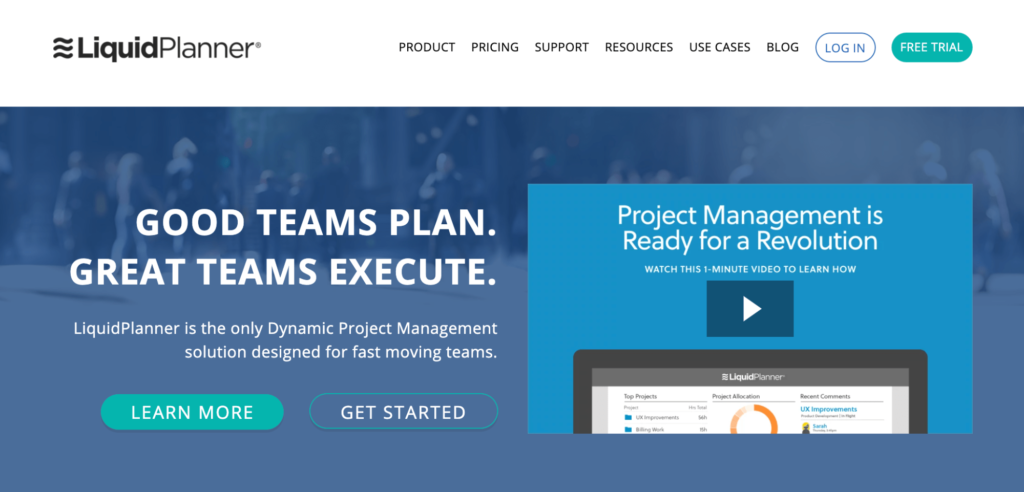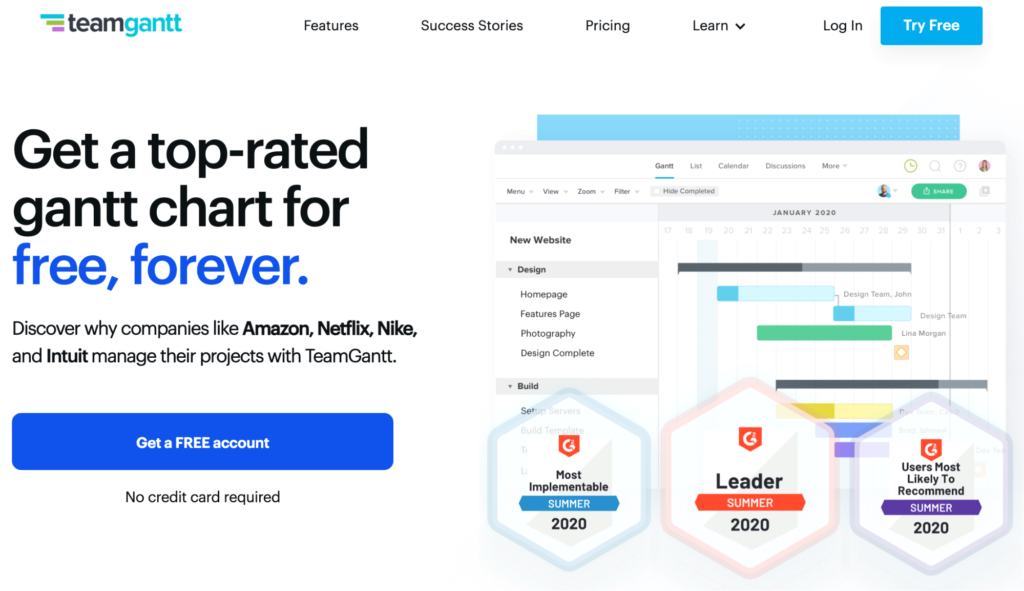Managing a project without planning ahead of time is like going on a road trip without a GPS or directions. There’s a good chance you’ll take some wrong turns, get lost, and probably won’t end up at your final destination in a timely fashion.
But unlike a road trip, project management has much higher stakes. Failing to plan will likely extend your project timeline, add to your costs, and potentially result in a subpar final deliverable.
To avoid these frustrations and wasted resources, it’s crucial to create a detailed project plan before the project starts.
As someone who has a ton of experience in this space, I’ll explain everything you need to know about effective project planning in this guide. Let’s dive in.
What is Project Management Planning?
There are five phases of project management—initiation, planning, execution, monitoring, and closure. Project planning is arguably the most important step of these five stages.
A project plan is formal documentation that defines the scope, goals, budget, timeline, and deliverables of a given project. It’s designed to get project managers and stakeholders on the same page before the actual project execution begins.
All project plans should describe tasks and activities required to reach the end goal, including resources to financing, risk, contingencies, and everything else involved with the project.
3 Tools to Improve Project Management Planning
The best way to write a project plan is with project management software. Here are a few of my favorite tools for success in this space.
#1 — TeamGantt
TeamGantt is an online project planning tool. As the name implies, the software is best known for its Gantt chart functionality. It’s a simple and effective way for teams of all sizes to plan and execute their projects from start to finish. Use it to organize, schedule, and manage projects with a user-friendly drag-and-drop interface. Project managers can monitor costs as well with time tracking and reporting tools.
For over a decade, the software has been used to create over 1.8 million projects and schedule more than 65 million tasks. More than one million users rely on TeamGantt. The software is free forever for small projects with up to three users. Business plans start at $19.90 per month. Try all of TeamGantt premium features for free with a 30-day trial.
#2 — Wrike
Wrike is another one of my favorite project planning tools. The software is trusted by 20,000+ organizations, including household names like Google, Dell, and Airbnb. It’s affordable and easy to use, regardless of your technical skill level. Wrike is highly versatile and can be used to manage projects throughout a wide range of different industries.
I love Wrike’s interactive Gantt charts. The charts are perfect for visualizing your project plans and creating dependencies between tasks. All of this can be managed through the intuitive drag-and-drop interface. Wrike also has excellent project templates that are ideal for planning. There are templates for project scheduling, product launches, proofing and approvals, product roadmaps, and more. The software is free for basic use, but that’s not ideal for business users. Paid plans start at $9.80 per user per month, and you can try Wrike for free with a 14-day trial.
#3 — LiquidPlanner

LiquidPlanner is a bit unique compared to some of the other project management tools on the market today. The software is only used by about 1,300 companies, so it’s not nearly as popular as other solutions. But with that said, LiquidPlanner is designed for a specific purpose. It’s the perfect solution for larger teams managing complex projects.
The tool is designed to help project managers take their plan to the next phase and ensure success throughout its execution. You can use it to plan project-level priorities as well as task-level priorities. LiquidPlanner helps calculate your estimated ranges to complete certain tasks and tells you how likely it is that you’ll get those tasks accomplished on schedule. The software is packed with automation and forecasting tools, which help manage complicated projects at scale. Pricing starts at $45 per user per month, and you can try LiquidPlanner for free with a 14-day trial.
The Basics of Project Management Planning
Project planning will vary from project to project, industry to industry. But at its core, every project plan should encompass the same key elements.
Define the Project Scope
Project planning will ultimately define your process for executing a project from start to finish. To do this effectively, the project manager needs to start by defining the project scope to ensure they’re on the same page as all key stakeholders.
Think of this as the story of your project. What is the end goal? How will you get to that end goal? What is the value of the project?
As project managers get briefed by stakeholders on what needs to be accomplished, certain aspects can get lost in translation. By defining the project scope and submitting a plan back to the stakeholders, they will be able to approve the plan before you begin.
At the earliest stage, project planning should define all major deliverables. It should also encompass how those project’s entire executables will be accomplished by a predefined deadline.
The project team and their roles should all be included in the initial project scope as well. Estimate how and when the team will meet the deliverables in time. Project plans should include everything from strategy to logistics.
Research
Most project plans require an extensive amount of research from the project manager. This helps get the facts straight as they are related to the total scope. You need to truly understand the fine details of a project before you can submit a proposal.
Part of the research process involves asking yourself some questions related to your project and team. Some of these will be easier to answer than others.
- What is the goal of the project?
- How much will the project cost?
- Who are the project sponsors and stakeholders?
- What is the availability of the sponsors and stakeholders?
- How will you communicate with stakeholders?
- Who owns the project, and who will provide the final sign-off?
- What elements could impact the project deadline?
- What project management framework or methodology will your team use to execute the project?
- Does your team have experience with this type of project before?
- Has your team worked together in the past?
- Are there elements of the project that stakeholders might not understand?
As you can see, a lot of this research goes above and beyond the basic project scope. In theory, any project plan could look good on paper. But when you factor in your team’s experience or outside stakeholders that want to be more involved than others, things don’t always go according to plan. All of this must be accounted for in the initial project plan.
Work Breakdown Structure (WBS)
Every project plan must describe a detailed work structure. While there is no standard method for describing your plan, many project managers like to use a work breakdown structure—commonly abbreviated as WBS.
This is a hierarchy of all items and systems related to a project. The top-level represents the entire system, whether it’s a product, software, facility, school, etc. Each subsequent level will consist of subsystems and individual components within each subsystem.
The work breakdown structure helps visually outline what should be developed throughout the project. It also helps define the relationships between tasks and components of the project.
Schedules and Timeline
Once you have a firm grasp of exactly what needs to be accomplished and how it’s going to be done, you need to start estimating your project schedule.
There are several different ways to do this, depending on the project scope and the framework you’re using. One popular option is critical path management (CPM). With CPM, project managers can calculate the path needed to complete tasks based on dependencies to the project’s most important activities.
Modern project management software has tools for CPM and other project scheduling solutions. A simple Gantt chart is one easy way to define project milestones and visually outline how the project will get completed.
It’s vital to understand how one task is dependent on another. If Task C can’t start until Task B is complete and Task B is behind schedule, it can derail your entire schedule. That’s also why contingencies and backup options should be included during the project planning process.
Project managers should also account for stakeholder expectations as they are estimating the timeline of deliverables.
Budgets
Cost is a major component of every project. So the budget must be accounted for in the beginning.
Some stakeholders will give the project manager a budget on day one. Other times, the project manager is expected to estimate the costs and submit a budget approval during the planning phase.
Regardless of the scenario, project managers must be able to match the allocation of resources with the schedule. From the project team labor to software, hardware, materials, equipment, contractors, and other costs associated with the project, the budgeting phase is extremely important.
Coming up with an accurate budget estimation in the project plan will make your life much easier throughout the project’s duration. With project management software, you should be able to track estimates vs. actual costs. You can also use tools to determine if you’re on track to complete the project within budget or if it looks like you’re going over.
Project Policies and Guidelines
Project plans should formally document all policies and guidelines pertaining to the overall scope. This will include communication procedures, constraints, and team expectations for the duration of the project.
How will team members be held accountable for their responsibilities? Who has the authority to make certain decisions or purchases on behalf of the project team? Do team members or contractors need to get approval before taking specific actions?
The project management methodology you’re using will provide a good amount of this framework. It can also help define the roles of stakeholders once the project has started.
Some deviation from the plan is expected for any project as unforeseen circumstances arise, and decisions must be made in real-time. But the policies and guidelines should ideally remain strict for the project duration.
3 Tricks For Project Management Planning
As someone who has been through the project planning process before, I know what it takes to succeed in this area. These are my three favorite quick tips and best practices for project plans.
Trick #1: Use Project Planning Software
Trying to plan a project by hand or on a spreadsheet is outdated and ineffective. All of the best project management software on the market today should contain project planning tools.
It’s the best way to plan schedules, manage teams, estimate costs, predict risk, and determine how to allocate resources. Some project management solutions will even come with project planning templates for you to follow and submit to stakeholders.
Once you move past the project planning stage, project management software will help you monitor and track your plan throughout the project’s entire execution.
Trick #2: Prioritize Transparency
Transparency should be a significant component throughout your project plan. From the project team up through the sponsors and stakeholders, everyone should understand the importance of being transparent.
People make mistakes. Things happen during a project that doesn’t always follow the plan.
Rather than trying to hide mistakes or sweep them under the rug, make sure your project team understands that they must be forward about their work. Hold them accountable for their actions without penalizing them for inevitable mistakes. If your team isn’t transparent with you, then you’ll have a tough time keeping stakeholders in the loop, which is a poor reflection on you.
But if you set these standards from the beginning and lead by example, the execution of your project plan will be much smoother.
Trick #3: Define Quality Standards in the Project Plan
The term “quality” can be a bit ambiguous with certain tasks and deliverables—it can vary from project to project. The stakeholder for one project might think a particular deliverable is excellent, while a stakeholder for another could see the same deliverable as below average.
It’s important for any project sponsors to be clear about these expectations and standards from the beginning so that you can convey the requirements to your team.
That’s another reason why all projects should be broken down into milestones instead of having one giant project with one final deliverable at the end. These milestones will help evaluate whether or not the project is on track to meet all quality standards, in addition to the budget and timeline.
It’s also helpful to establish a clear baseline for quality that has been signed off on by the key stakeholders. As long as your deliverables meet this baseline, the project will be considered a success.
from Quick Sprout https://ift.tt/3mCKeeo
via IFTTT


